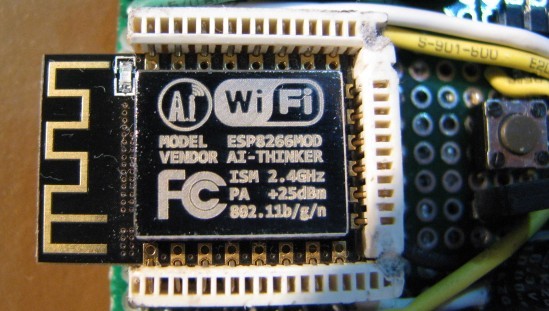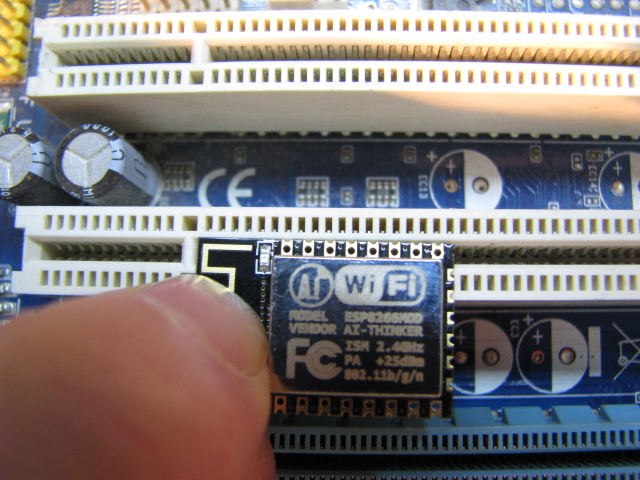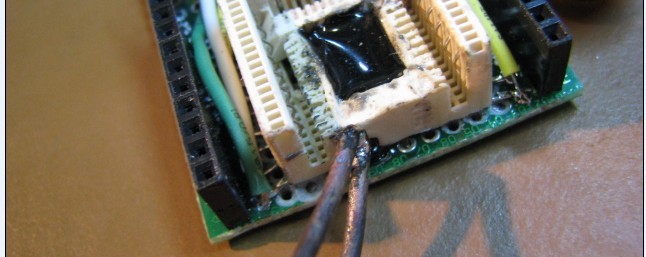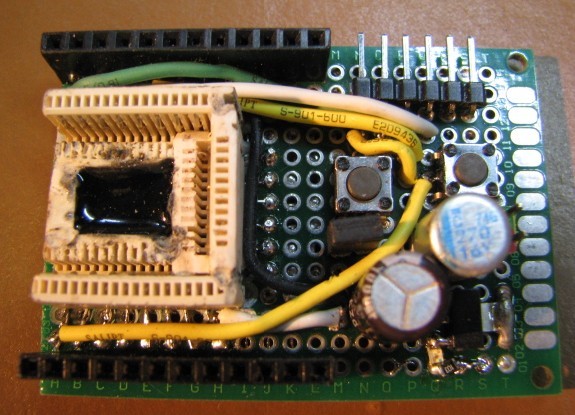DIY connector for ESP8266 ESP-12
Much has been written, written, created many sites dedicated to the module ESP8266.
Today to add something new about it is very difficult. And to repeat and voice what has already been said is not always correct and interesting.
So I was attracted by this module, and I ordered several pieces from China. When I realized that this is a huge field for creativity, the task became: how, without buying various adaptations that are not always necessary, to program it. Here is the solution I found:

')
If you are already interested, then go ahead.
The soldering of wires and resistances to the module itself, for programming, is not always convenient.
As in the final version, the module can be arranged with elements in different ways.
One of my subscribers (user) advised me to pay attention to the motherboard connectors. And indeed, I have almost a whole mountain under my feet (sometimes I attack), I just don’t notice them anymore.


And so I picked up the motherboard and let's apply the module.
And so I found out that the PCI slot is not suitable because of its pitch.

AGP or PCI-Express can come up.

AGP connector, personally, I did not particularly like because of the height of the slot.

For this, I chose PCI-Express. Yes, and I have more “motherboard” with this slot, I have something to train on.
To dismantle the slot, you need a hairdryer (280-400 degrees), or a burner, in extreme cases a gas stove will do (I used to do that). When bad warming up there are incidents:

Slightly moving the remnants of the "gray matter", I realized that you need not just to divide the connector, but to provide a seat. And it needs to be done at such a level that the contact and clamping is maximum. For this it is necessary to sacrifice a symmetrical half, cutting it off to the level of the future site.

Next comes the drill machine (not relevant because of the high revolutions), wire cutters and a pulse soldering iron (with copper wire instead of a sting), as well as a clerical knife. We begin to pick a slot, to determine the level of bending for the contact. We try to cut off smoothly, from this envy even fit of the module.

So you need to thin out through one contact, gently pulling them to the bottom of the connector (be careful - they are fragile). It is also necessary to roughly form the shape of the connector and provide for the glue slot (spike) between the bottom and the top of the body to each other — do not rush to bite everything off if you do not have several slots in stock.
I taped everything with a pulsed soldering iron, he did an excellent job with this task (and the wire on the soldering iron is not a pity).

So that the U-shaped connector does not diverge, when a module is inserted into it, I made an additional jumper from a slot piece. So the module has become more reliable.
Hot-melt glue helped me securely attach the connector to the board.

I did not have time and there is not always enough space to erase the board, so I used the prototype PCB board. This option is always convenient when you need to add or remove a part.
This is the board I got:

On it, I upload firmware and programs. Now it is possible to use another module in various devices.
I used this slot in my video review on ESP8266, you can clearly see how easy it is with it:
If you have slots and a desire to repeat, then I am sure that you will succeed even better than me.
Thank you all for your attention, I hope that the commun will benefit from this idea.
Today to add something new about it is very difficult. And to repeat and voice what has already been said is not always correct and interesting.
So I was attracted by this module, and I ordered several pieces from China. When I realized that this is a huge field for creativity, the task became: how, without buying various adaptations that are not always necessary, to program it. Here is the solution I found:

')
If you are already interested, then go ahead.
The soldering of wires and resistances to the module itself, for programming, is not always convenient.
As in the final version, the module can be arranged with elements in different ways.
One of my subscribers (user) advised me to pay attention to the motherboard connectors. And indeed, I have almost a whole mountain under my feet (sometimes I attack), I just don’t notice them anymore.


And so I picked up the motherboard and let's apply the module.
And so I found out that the PCI slot is not suitable because of its pitch.

AGP or PCI-Express can come up.

AGP connector, personally, I did not particularly like because of the height of the slot.

For this, I chose PCI-Express. Yes, and I have more “motherboard” with this slot, I have something to train on.
To dismantle the slot, you need a hairdryer (280-400 degrees), or a burner, in extreme cases a gas stove will do (I used to do that). When bad warming up there are incidents:

Slightly moving the remnants of the "gray matter", I realized that you need not just to divide the connector, but to provide a seat. And it needs to be done at such a level that the contact and clamping is maximum. For this it is necessary to sacrifice a symmetrical half, cutting it off to the level of the future site.

Next comes the drill machine (not relevant because of the high revolutions), wire cutters and a pulse soldering iron (with copper wire instead of a sting), as well as a clerical knife. We begin to pick a slot, to determine the level of bending for the contact. We try to cut off smoothly, from this envy even fit of the module.

So you need to thin out through one contact, gently pulling them to the bottom of the connector (be careful - they are fragile). It is also necessary to roughly form the shape of the connector and provide for the glue slot (spike) between the bottom and the top of the body to each other — do not rush to bite everything off if you do not have several slots in stock.
I taped everything with a pulsed soldering iron, he did an excellent job with this task (and the wire on the soldering iron is not a pity).

So that the U-shaped connector does not diverge, when a module is inserted into it, I made an additional jumper from a slot piece. So the module has become more reliable.
Hot-melt glue helped me securely attach the connector to the board.

I did not have time and there is not always enough space to erase the board, so I used the prototype PCB board. This option is always convenient when you need to add or remove a part.
This is the board I got:

On it, I upload firmware and programs. Now it is possible to use another module in various devices.
I used this slot in my video review on ESP8266, you can clearly see how easy it is with it:
If you have slots and a desire to repeat, then I am sure that you will succeed even better than me.
Thank you all for your attention, I hope that the commun will benefit from this idea.
Source: https://habr.com/ru/post/277825/
All Articles